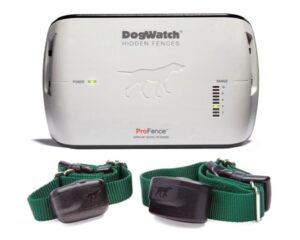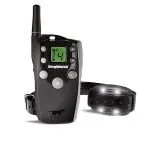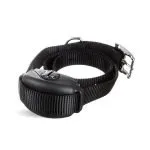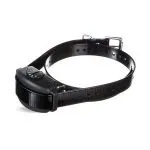Frequently Asked Questions About the DogWatch BarkCollar™
The BarkCollar™ serves as a reliable tool for diminishing and ultimately eliminating excessive barking behavior.
Inside the BarkCollar™, there is a built-in sensor that springs into action when your dog barks. Following a brief three-second grace period known as the ‘bark-forgiveness’ phase, the collar becomes active and administers either a gentle vibration or electronic stimulation. You have the flexibility to adjust the vibration or stimulation level, ensuring it’s precisely tuned to distract your dog from barking without causing discomfort.
Should your dog persist in barking, the intensity of the vibration or stimulation gradually escalates, moving from the minimum to the maximum level as per your chosen setting. Over time, your dog establishes a connection between barking and the sensation, learning that the sensation ceases when the barking does, ultimately promoting a reduction in excessive barking behavior.
Proper placement of the collar strap is crucial for its effectiveness. It should be positioned on the smallest part of your dog’s neck, just below their ears. It must fit snugly to ensure that the contact posts are in direct contact with the center of the dog’s neck, where the vibrations produced by the dog’s barking can be accurately detected. If the collar is too loose or not centered correctly on the dog’s neck, it may not effectively detect the barking behavior.
The battery life of the collar is contingent on both the frequency of use and your dog’s barking habits. A collar that is worn for extended periods and triggered frequently will naturally require more frequent recharging compared to a collar worn for shorter durations with less frequent activations. Typically, when a collar is worn daily and experiences low to moderate activation, a single charge can last for a month or even longer. This means that with regular use and appropriate settings, you can enjoy extended periods of functionality between recharges.
Indeed, the rechargeable battery in the collar is designed to last several years, providing reliable and long-lasting performance. It’s important to keep an eye on the battery’s performance, and if you notice a significant decrease in the duration of a single charge, it’s time to consider a replacement. Replacement batteries are readily available from DogWatch, and the process of replacing the battery is straightforward and user-friendly, ensuring continued functionality for your collar with minimal hassle.
Absolutely, when there’s no need for the collar to be on your dog, it’s advisable to remove it and turn it off. This practice not only conserves the collar’s battery life but also helps prevent any potential skin irritation, particularly if your dog wears the collar continuously. Many pet owners find it beneficial to remove the collar at night or during times when the corrective features are not required, ensuring the comfort and well-being of their furry companions.
To start using the BarkCollar™ with your dog, follow these steps:
1. Turn on the BarkCollar™ and set it to ‘V’ for Vibration mode.
2. Place the BarkCollar™ on your dog.
3. Observe your dog’s behavior while they bark. Look for any response such as a head shake, ear twitch, or a change in barking behavior.
4. If you don’t notice any reaction or if your dog continues to bark without responding to the collar, increase the setting by one level and repeat the process.
5. Keep observing your dog’s reaction, and when you see a subtle response to the collar, that setting is a good starting point for your training.
This gradual approach allows you to find the appropriate vibration level that effectively discourages excessive barking while ensuring your dog’s comfort during the training process.
The rate at which your dog’s behavior changes can vary based on several factors, including your dog’s personality, the frequency of triggers for barking, and your dog’s ability to remain focused despite distractions when barking. In most cases, dogs typically begin to associate their barking with the sensation from the vibration or stimulation after experiencing the collar’s activation multiple times.
The speed at which barking behavior diminishes can vary widely among individual dogs. Some dogs may quickly adapt and reduce their barking, while others may require a more gradual process of training and behavior modification.
If you notice that there’s no noticeable improvement in your dog’s barking behavior after a reasonable trial period, it’s a good idea to check the collar’s fit to ensure it’s snug and the contact posts are the correct size. If the collar fits correctly and your dog continues to bark excessively, you can consider increasing the BarkCollar setting by one level, always taking your dog’s comfort and well-being into account throughout the training process.
To ensure that the BarkCollar™ is functioning properly, follow these steps:
1. Turn on the BarkCollar™.
2. Check the Status Light on the BarkCollar™. If it blinks green, this indicates that the battery is charged, and the BarkCollar™ is in working order.
Additionally, there is an auto “self-test” feature in the collar to confirm its functionality. This self-test is designed to provide assurance that the BarkCollar™ is operating as intended, further ensuring its reliability in training your dog effectively.
The auto “self-test” feature built into the BarkCollar™ is a valuable tool for confirming the collar’s functionality and ensuring it’s operating correctly. Whenever you turn the collar “on” or make changes to its settings, it will initiate a brief vibration and illuminate the status light. This automatic self-test serves as a reassuring confirmation that the BarkCollar™ is not only charged but also in good working order, providing peace of mind as you use it for training your dog.
The BarkCollar™ is designed to be effective on dogs as small as 4 pounds. Its suitability for smaller dogs makes it a versatile option for various breeds and sizes, ensuring that it can assist in training and reducing excessive barking behavior in dogs of varying sizes and weights.
It’s recommended to wait until your dog is between 4 to 6 months old before using the BarkCollar™ for training purposes. This age range is typically when dogs have developed enough physically and mentally to effectively respond to training techniques like those provided by the BarkCollar™. It’s important to consider your dog’s individual development and temperament when deciding on the appropriate timing for introducing training tools like this collar. Always ensure that any training method is safe, humane, and suitable for your dog’s age and needs.
No, the electronic stimulation is gentle in nature. Picture it as a subtle tickle or a faint static sensation, much like the feeling of touching a metal doorknob after walking across carpet. This stimulation serves to capture your pet’s attention, akin to a gentle tap on the shoulder.
No, for the collar to be activated, it must maintain direct contact with your dog’s neck. This ensures that the collar’s sensors can effectively detect your dog’s barking behavior and provide the appropriate response as part of the training process.
Yes, your dog can wear both the Hidden Fence collar and the BarkCollar simultaneously. These collars serve different purposes, with the Hidden Fence collar designed for containment and the BarkCollar aimed at reducing excessive barking behavior. It’s safe for your dog to wear both collars when needed, ensuring that they can enjoy the benefits of both systems simultaneously.
Yes, the BarkCollar™ is waterproof. Its design allows it to be worn by your dog in various weather conditions, including rain or when your dog is near water. This waterproof feature ensures that the collar remains effective and functional even in wet environments, providing consistent training and behavior modification for your pet.
Yes, there is a one-year warranty on the BarkCollar™. This warranty provides coverage and support for the product during the specified period, offering peace of mind to pet owners in case of any manufacturing defects or issues with the collar during the warranty duration.
When determining which contact posts to use for the BarkCollar™, consider the length and thickness of your dog’s coat:
– For dogs with long hair or a thick coat, we recommend using long contact posts. These longer posts ensure that the collar maintains proper contact with the skin and can effectively detect barking behavior.
– For dogs with short hair and no thick coat, short contact posts should suffice. These shorter posts are suitable for dogs where a less significant barrier exists between the collar and the skin.
Selecting the appropriate contact posts based on your dog’s coat type helps ensure the collar’s effectiveness and your pet’s comfort during training.
Weather can indeed impact how the BarkCollar™ operates, especially in extreme temperature conditions. Here’s some information on its temperature specifications:
The components in the BarkCollar™ are designed to function within a temperature range of minus 25 degrees Fahrenheit to 125 degrees Fahrenheit. However, it’s important to note that a significant and rapid change in temperature, especially extreme cold or hot conditions, may temporarily affect some of the BarkCollar functions. The device may require a brief adjustment period to adapt to the new temperature level.
Understanding these temperature limitations can help ensure the reliable operation of the BarkCollar in various weather conditions and provide a more effective training experience for your dog.








